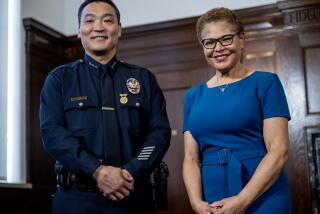Next Year’s Model
- Share via
John C. “Jack” Shaw recently dropped out of the doctoral program at the Peter F. Drucker Graduate Management Center at Claremont Graduate University.
That’s because the prestigious business school hired him as its dean.
Shaw, 64, brings four decades of experience in accounting, computing, consulting and teaching to the position. Among other jobs, he was executive vice president of WellPoint Health Networks Inc. and vice chairman of Deloitte & Touche Consulting Group. He also is a founder of Shaw Group, a consulting firm focusing on strategic corporate transformations.
He is a sought-after speaker and the author of five books, including “The Service Focus: Developing Winning Game Plans for Service Companies” (Dow Jones-Irwin, 1989).
Just three months into his deanship, Shaw talked recently about the state of leadership in corporate America.
Question: How does a business school teach students to be good leaders, given the changes occurring in the corporate world?
Answer: I distinguish between leadership and management. There is the hard science of management and then the soft human side--it’s both a left- and a right-brain exercise. Most business schools teach the quantitative side. We try to say there’s also a human side.
I think a lot of places can teach management, which is by now a fairly well-defined body of knowledge about how you break down tasks, organize around the task to be performed, delegate the responsibility and authority to get things done, and oversee the work. It is the model of the last 50 or maybe 100 years. That’s the past.
You’re asking a question about the future of leadership, which is the ability to understand the purpose of an organization over the long run. If you look at the kinds of perspectives that you want the leader of the future to have, it’s about defining the purpose of the institution or enterprise. Why are we here? What’s our purpose or mission? The role of the leader is to define the future. Here at Claremont, our concept is to link the creation of knowledge about leadership to the practice of management.
We’re literally creating knowledge. [Claremont professor] Jean Lipman-Blumen’s book “The Connective Edge: Leading in an Interdependent World” (Jossey-Bass, 1996) defines the role of the leader of the future. We created that “thoughtware,” as I call it. Our basic purpose is to create knowledge and distribute that knowledge to the practitioners of management. Jean has now gone way out and developed something extraordinary that we now need to build courses around, to teach practicing managers the principles embodied in it.
*
Q: How is this new world different?
A: The classic bureaucratic model is hierarchical, a command-and-control model that we’ve all disproved by now. Everybody reports to somebody else. Everybody has a boss. Authority and responsibility are delegated downward.
Jean’s model is a flat organization where everyone is connected to everyone else. Knowledge workers perform the tasks or work with others in a connective way to get work done. There’s no permanent relationship between any of us. You connect up when you need to connect up to get your work done.
*
Q: In your view, what are some examples of good and bad leadership in corporate America today?
A: If you look at what [General Electric Co. Chief Executive] Jack Welch has done, that’s the most obvious model [of a good leader]. He [set about] fixing an already successful company and establishing a whole new way of thinking about the businesses they’re in.
That was the first phase. Now he’s in the process of literally pushing the responsibility for all those businesses as far down as he possibly can. He has reinvented that company at least two or three times.
Hewlett-Packard Co. is another good example, an organization that is basically values-based. They’ve been able to change the organization a lot without killing the company. There is a fundamental HP way of doing things. Look at the opposite of that--Digital Equipment Corp. They lost the company because they weren’t able to change.
IBM almost lost it until they were able to reconceptualize and build a new way of thinking about their organization, without throwing out the baby [the company’s mainframe business] with the bathwater. I’m staying away from the word “vision” here [because] I don’t think it changed a lot. But they really did recognize the drivers of the new industry they were in, particularly the Internet and the whole connective nature of information.
Sears, Roebuck & Co. went to the brink and, with new leadership [Chairman Arthur Martinez, formerly of Saks Fifth Avenue], has . . . gone back to a customer focus, transitioning from a product and distribution company. The jury is out. Everybody has to perform over the long run, but they certainly have gotten it back on track again.
*
Q: How would you characterize the leadership ability of Albert Dunlap, the turnaround CEO who heads Sunbeam Corp. and has been nicknamed “Chainsaw Al” for his tendency to whack payroll?
A: I’m not sure as dean of the Drucker center I want to take on Al Dunlap in your pages. But when we come back to what’s the purpose of the organization, it’s really to make a difference, to leave something behind, to serve a multitude of constituencies and not just the shareholder.
Shareholders are important, but you wouldn’t be there if you didn’t have customers--or employees, for that matter. Many executives are turnaround experts, but ultimately the patient dies because the turnaround wasn’t values-based. For the most part, if you’re able to change the lives of your customers and give your employees security, the share owners will benefit. If you start with the share owner and say, “I’ve got to hype the share price,” without putting the employee and the customer first, you get a short-term boost.
*
Q: What can employees at all levels do to improve their leadership skills?
A: I can give you some personal experience. I think it’s all about lifetime education, something I’ve practiced. I believe that the responsibility for one’s life and one’s success lies within oneself. It’s not in government, not in the corporation, and in today’s world, it’s not even in the family. . . .
The idea is to make individuals responsible for themselves, to make them think: “What could I do to improve myself if this job or company went away or if innovation eliminated the need for my job? I need to be constantly educating myself so that I can be ready for my next job.” Workers would be happier and more self-confident if they saw themselves personally grow.
I’ve been a lifetime learner, as has [management philosopher] Peter Drucker. [But this strategy would work as well] for the file clerk or the data-processing person, if they’re able to take advantage of employee-sponsored education or community colleges or Internet-based learning. One has to have the motivation to invest in oneself as opposed to sitting in front of the TV and being entertained. If you already have a master’s degree, get another one. If you have a degree in a field that’s becoming saturated--say, aerospace and defense--go get another field while you’re still young enough.
*
Q: Is this really practical for most people?
A: Technology makes it so.
*
Q: It’s one thing to lead in good economic times, as we have now. Where are the leaders for the rough times?
A: Some companies that I talk to are thinking about outsourcing their “corporate universities.” Toyota Motor Sales USA in Torrance is looking into it. [The company’s] former vice president of human resources is now dean of the Toyota University. They’re never going to have teachers on staff. They will out-source [education and training] to various organizations, ours and others, for the best and latest teachings. That’s their way of making their employees more relevant for the future.
*
Q: What about Microsoft Corp.’s Bill Gates, who is embattled at the moment, given the government antitrust suit?
A: I think it’s a mixed bag. He was brilliant in capturing the high ground in the first place, getting his operating system to be the ubiquitous standard in the computer industry. Another brilliant stroke was the turnaround of the company when he recognized that the Internet would be the wave of the future. He turned Microsoft into an Internet company in six months. In that sense, he has invented the company twice, a heck of an achievement.
Whether his style of leadership will become permanent like HP’s is an open question, whether the son of Gates, so to speak, will be able to pass on [leadership style] the way [William] Hewlett and [David] Packard passed on their leadership and values. The question is: Do you leave behind a company that’s sustainable and has permanence as an institution? Can leaders turn over the reins in an orderly fashion several times and have the institution continue to prosper? I think that’s the real test of leadership.



